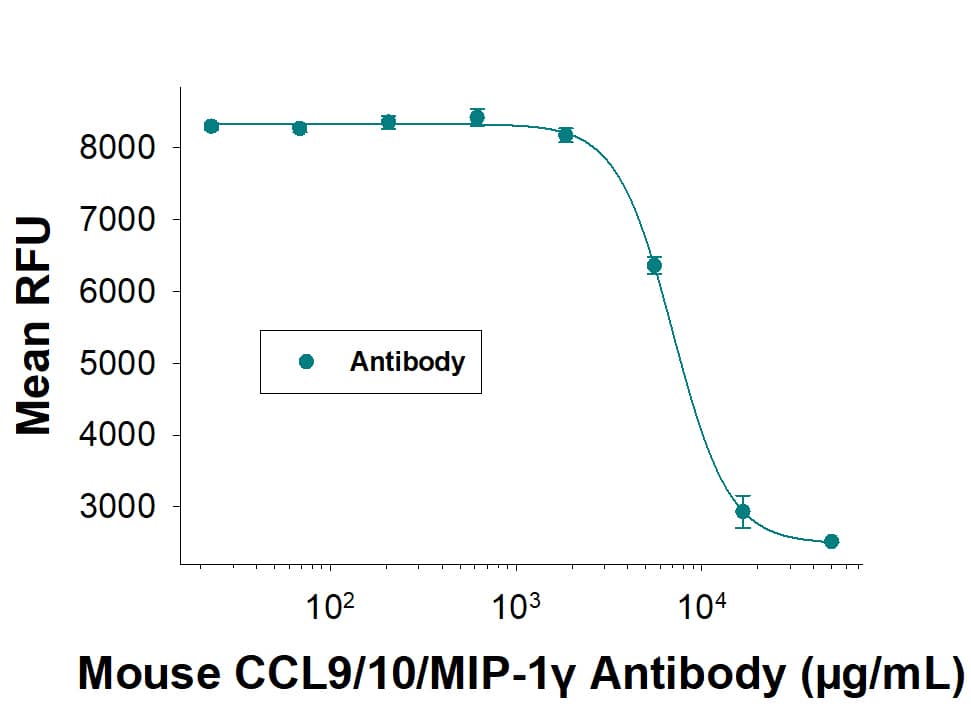Mouse CCL9/10/MIP-1 gamma Antibody Summary
Gln22-Gln122
Accession # P51670
*Small pack size (-SP) is supplied either lyophilized or as a 0.2 µm filtered solution in PBS.
Applications
Mouse CCL9/10/MIP-1 gamma Sandwich Immunoassay
Please Note: Optimal dilutions should be determined by each laboratory for each application. General Protocols are available in the Technical Information section on our website.
Scientific Data
 View Larger
View Larger
Neutralization by Mouse CCL9/10/ MIP 1 gamma Antibody Mouse CCL9/10/MIP 1 gamma Antibody Clone # 62105 (Catalog # MAB463) neutralizes CCL9/10/MIP-1 gamma (463-MG) induced chemotaxis in the BaF3 mouse pro-B cell line transfected with human CCR1. The Neutralization Dose (ND50) for this effect is typically 1.50-15.0 µg/mL in the presence of 1.00 μg/mL Recombinant Mouse CCL9/10/MIP-1 gamma.
Reconstitution Calculator
Preparation and Storage
- 12 months from date of receipt, -20 to -70 °C as supplied.
- 1 month, 2 to 8 °C under sterile conditions after reconstitution.
- 6 months, -20 to -70 °C under sterile conditions after reconstitution.
Background: CCL9/10/MIP-1 gamma
Mouse CCL9/10 (also named MIP-1 gamma and MRP-2) is an 11 kDa, secreted, monomeric polypeptide that belongs to the beta (or CC) intercrine family of chemokines (1‑3). Based on its activity and amino acid (aa) sequence, it is further classified as a member of the NC6 or six cysteine-containing CC subfamily of chemokines (2, 4, 5). This subfamily contains four N-terminally extended chemokines, two human (CCL15 and CCL23) and two mouse (CCL9 and CCL10). Within this subfamily, there are no human-to-rodent interspecies orthologs. Mouse CCL9/10 is synthesized as a 122 aa precursor that contains a 21 aa signal sequence and a 101 aa mature region with six cysteines. As noted, the mature region has an expanded N-terminus relative to other CC family members, and it forms a third intrachain disulfide bond with its two extra cysteines (3‑7). Mouse CCL9/10 is 75% aa identical to rat CCL9/10 (8). Chemokines are known to undergo proteolytic processing to generate multiple isoforms. NC6 chemokines are usually only marginally active at full‑length, but are converted to highly active forms upon N-terminal truncation. Mature CCL9, in the presence of inflammatory fluids, is naturally truncated by 28, 29 or 30 aa at the N-terminus, generating a highly active, 8 kDa, 71‑73 aa CCR1 ligand. In contrast, other CCR1 ligands, CCL3/MIP-1 alpha and CCL5/RANTES, lose their potency when proteolytically processed. CCL9/10 is constitutively secreted, and circulates as a full‑length molecule. Any onset of inflammation with subsequent enzyme release may act on local NC6 chemokines, generating early, potent leukocyte chemoattractants (5, 7).
- Zlotnik, A. and O. Yoshie (2000) Immunity 12:121.
- Zlotnik, A. et al. (1999) Crit. Rev. Immunol. 19:1
- Mohamadzadeh, M. et al. (1996) J. Immunol. 156:3102.
- Haelens, A. et al. (1996) Immunobiology 195:499.
- Berahovich, R.D. et al. (2005) J. Immunol. 174:7341.
- Youn, B-S. et al. (1995) J. Immunol. 155:2661.
- Poltorak, A.N. et al. (1995) J. Inflamm. 45:207.
Product Datasheets
Citations for Mouse CCL9/10/MIP-1 gamma Antibody
R&D Systems personnel manually curate a database that contains references using R&D Systems products. The data collected includes not only links to publications in PubMed, but also provides information about sample types, species, and experimental conditions.
8
Citations: Showing 1 - 8
Filter your results:
Filter by:
-
Chemokine CCL9 Is Upregulated Early in Chronic Kidney Disease and Counteracts Kidney Inflammation and Fibrosis
Authors: C Hemmers, C Schulte, J Wollenhaup, DWL Wong, E Harlacher, S Orth-Alamp, BM Klinkhamme, SH Schirmer, M Böhm, N Marx, T Speer, P Boor, J Jankowski, H Noels
Biomedicines, 2022-02-10;10(2):.
Species: Mouse
Sample Types: In Vivo
Applications: Neutralization -
Cytotoxic T cells swarm by homotypic chemokine signalling
Authors: Jorge Luis Galeano Niño, Sophie V Pageon, Szun S Tay, Feyza Colakoglu, Daryan Kempe, Jack Hywood et al.
eLife
-
Astroglial TLR9 antagonism promotes chemotaxis and alternative activation of macrophages via modulation of astrocyte-derived signals: implications for spinal cord injury
Authors: L Li, L Ni, RF Heary, S Elkabes
J Neuroinflammation, 2020-02-25;17(1):73.
Species: Mouse
Sample Types: Whole Cells
Applications: Neutralization -
Novel chemokine-like activities of histones in tumor metastasis
Authors: R Chen, Y Xie, X Zhong, Y Fu, Y Huang, Y Zhen, P Pan, H Wang, DL Bartlett, TR Billiar, MT Lotze, HJ Zeh, XG Fan, D Tang, R Kang
Oncotarget, 2016-09-20;7(38):61728-61740.
Species: Human
Sample Types: Whole Cells
Applications: Neutralization -
Loss of muscleblind-like 1 promotes invasive mesenchyme formation in endocardial cushions by stimulating autocrine TGF beta 3
Authors: Kathryn E LeMasters, Yotam Blech-Hermoni, Samantha J Stillwagon, Natalie A Vajda, Andrea N Ladd
BMC Developmental Biology
-
Response patterns of cytokines/chemokines in two murine strains after irradiation.
Authors: Zhang M, Yin L, Zhang K, Sun W, Yang S, Zhang B, Salzman P, Wang W, Liu C, Vidyasagar S, Zhang L, Ju S, Okunieff P, Zhang L
Cytokine, 2012-01-25;58(2):169-77.
Species: Mouse
Sample Types: Plasma
Applications: Luminex Development -
MIP-1 gamma promotes receptor-activator-of-NF-kappa-B-ligand-induced osteoclast formation and survival.
Authors: Okamatsu Y, Battaglino R, Spate U, Stashenko P
J. Immunol., 2004-08-01;173(3):2084-90.
Species: Mouse
Sample Types: Whole Cells
Applications: Neutralization -
Synthesis of several chemokines but few cytokines by primed uncommitted precursor CD4 T cells suggests that these cells recruit other immune cells without exerting direct effector functions.
Authors: Mosmann T
Eur. J. Immunol., 2004-06-01;34(6):1617-26.
Species: Mouse
Sample Types: Cell Culture Supernates
Applications: ELISA Development, ELISpot Development
FAQs
No product specific FAQs exist for this product, however you may
View all Antibody FAQsReviews for Mouse CCL9/10/MIP-1 gamma Antibody
There are currently no reviews for this product. Be the first to review Mouse CCL9/10/MIP-1 gamma Antibody and earn rewards!
Have you used Mouse CCL9/10/MIP-1 gamma Antibody?
Submit a review and receive an Amazon gift card.
$25/€18/£15/$25CAN/¥75 Yuan/¥2500 Yen for a review with an image
$10/€7/£6/$10 CAD/¥70 Yuan/¥1110 Yen for a review without an image
